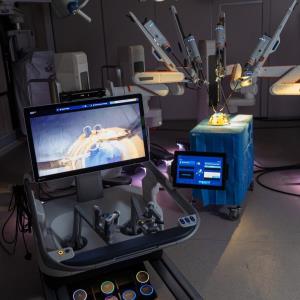Researchers have developed an artificial intelligence (AI)-enabled tool that can automatically detect vital steps during robotic-assisted radical prostatectomy (RARP) with high accuracy.
“Automated surgical video analysis has immediate practical applications in surgeon video review, surgical training and education, quality and safety benchmarking, medical billing and documentation, and operating room logistics,” said the researchers, led by Abhinav Khanna, Department of Urology, Mayo Clinic, Rochester, Minnesota, US.
A team of image annotators manually interpreted surgical videos from RARP under the supervision of two urologic oncologists. They labeled full-length surgical videos to identify all steps involved in surgery. These annotated videos were then used to train a computer vision algorithm to carry out automated video annotation of RARP surgical video.
To assess the accuracy of automated video annotations, Khanna and colleagues compared these to manual human annotations which served as the reference standard.
In total, 474 full-length RARP videos (median 149 minutes) went through manual annotations with surgical steps. Of these, 292 were used as a training dataset for algorithm development, 69 for internal validation, and 113 as a separate testing cohort evaluating algorithm accuracy. [J Urol 2024;211:575-584]
Concordance was high (92.8 percent) between AI-enabled automated video analysis and manual human video annotation. The accuracy of the algorithm was highest for the vesicourethral anastomosis step (97.3 percent) and lowest for the final inspection and extraction step (76.8 percent).
Surgeon training
“Our AI step detection tool also has potential applications in surgical training,” the researchers said. “Video review has previously been suggested as a valuable tool in training novice surgeons and refining skills among experienced surgeons.” [Medicine (Baltimore) 2018;97:e13569; Nat Rev Urol 2019;16:261-267; J Surg Educ 2022;79:1480-1488]
A recent study has shown that the use of a structured video with step labeling can help accelerate video review among surgeons and trainees. On the other hand, manual labeling of surgical video footage is “laborious, time intensive, and expensive,” which can potentially limit its adoption. [J Robot Surg 2023;17:695-701]
“The current study overcomes this obstacle by fully automating the process of video labeling using a novel AI platform, which may facilitate targeted video review of individual surgical steps,” the researchers said.
Documentation
The novel AI tool can also be useful in billing and documentation. Currently, surgeons generate surgical operative reports in narrative form, which is subjective and prone to inaccuracies. [Am Surg 2005;71:627-632; JAMA Surg 2019;154:381-389; Br J Surg 2013;100:426-432; Am J Otolaryngol 2016;37:330-333; Can J Surg 2013;56:E121-E127]
“Additionally, surgical operative reports serve as the basis of medical billing, which represents a potential opportunity for increased transparency and improved billing accuracy,” the researchers said. [Am Surg 2004;70:570-575]
“An AI model that is capable of automatically detecting lymphadenectomy during RARP surgical video could potentially serve as the basis for video-based medical billing in the future,” they added.

